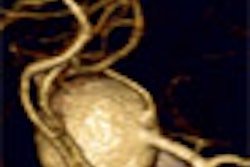Steroids delivered by ultrasound-guided tendon sheath injections could be a safe and inexpensive way to treat pediatric rheumatoid arthritis (RA) and other autoimmune diseases, according to Canadian researchers.
In a study presented at the 2002 Society of Interventional Radiology (SIR, formerly SCVIR) meeting earlier this month in Baltimore, Dr. Bairbre Connolly and colleagues from the Hospital for Sick Children in Toronto retrospectively reviewed the treatment results of 87 children, ages 1-17, most of whom had juvenile RA. The children received 285 injections (6-10 mg) of the therapeutic drug triamcinalone hexacetonide, mostly in the foot and ankle. A 10-MHz linear probe was used for ultrasound guidance during needle localization and steroid administration.
According to the results, 34% of the patients were classified as complete responders, and 31% were partial responders to the drug therapy. "This is a service that is easily developed and has good potential," Connolly said.
No serious side effects, such as tendon ruptures or infections, were reported. Four cases of skin atrophy were noted, although Connolly said that adverse events were generally underreported.
She also cautioned that the study was retrospective, and that the results would need to be confirmed in a controlled trial. In addition, the measures used to evaluate response did not focus on the individual sites of injection. These factors will need to be addressed in future studies, she said.
"Our rheumatology colleagues think it has high clinical impact," Connolly said, "but we haven’t proved that."
Previous researchers have also reported success with ultrasound-guided steroid delivery. A group from the University of Ancona in Italy assessed local injection therapy of small joints with sonography. Images captured with a 13-MHz transducer enabled the morphostructural assessment of soft-tissue involvement, joint cavity widening, and tendon sheath widening (Annals of the Rheumatic Diseases, October 1999, Vol.58:10, pp. 595-597).
"Ultrasound-guided placement of the needle within the joint and injection of corticosteroid under sonographic control can be easily performed," the Italian researchers wrote.
By Brian ReidAuntMinnie.com contributing writer
April 22, 2002
Related Reading
Dynamic MRI study differentiates leflunomide versus methotrexate for RA, March 14, 2002
Radiologic signs of joint healing can be accurately identified in RA patients, January 7, 2002
Initial x-rays, rheumatoid factor predict damage from rheumatoid arthritis, September 6, 2001
Quantitative ultrasound can detect early rheumatoid arthritis, July 19, 2001
Copyright © 2002 AuntMinnie.com



















